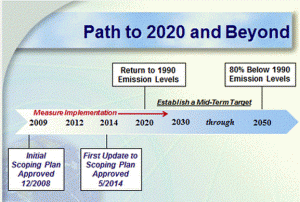Alternative fuel companies cheer, oil industry questions CA carbon regulations
 The California Air Resources Board’s plan to renew the Low Carbon Fuel Standard elicited cheers at a recent Board meeting from its main beneficiary: alternative fuel companies. More lukewarm was the petroleum industry, which could lose billions of dollars as it transitions to a new business model.
The California Air Resources Board’s plan to renew the Low Carbon Fuel Standard elicited cheers at a recent Board meeting from its main beneficiary: alternative fuel companies. More lukewarm was the petroleum industry, which could lose billions of dollars as it transitions to a new business model.
The LCFS, which was enacted in 2009, requires California’s fuel producers to reduce the greenhouse gas emissions of their fuel by 10 percent by 2020 (compared to 2010 levels). It’s a major component, along with cap-and-trade, of California’s AB32, the Global Warming Solutions Act of 2006. That act requires the reduction of greenhouse gas emissions in the state to 1990 levels by 2020.
CARB officials called the LCFS a success story at their recent meeting, although greenhouse gas emissions from fuel have been reduced by only 1 percent so far. Lawsuit challenges and new research on alternative fuel carbon levels have prompted CARB to revise and reauthorize the regulations. A final vote to update them is planned for this summer, with implementation to begin in 2016.
A 2012 study by the Boston Consulting Group for the Western States Petroleum Association predicts California’s economy will take a hit when the full force of the regulations takes effect in 2020:
- “Due to forecasted refinery closures, California could lose 28,000-51,000 jobs, including many high-paying skilled manufacturing jobs, as well as indirect job losses due to multiplier effects.
- “California could lose up to $4.4 billion of tax revenue per year by 2020 resulting in further reduction in employment in certain areas (e.g., road maintenance, local businesses).
- “There will be a wealth transfer of at least $3.7 billion per year by 2020 from refineries and fuel suppliers to the California Air Resources Board as a result of purchasing allowances.
- “Other negative impacts include loss of manufacturing expertise and increased cost of living resulting from higher fuels cost, disproportionately impact[ing] low-income households.
- “California’s climate change regulations will discourage energy intensive industries from locating in the state, and existing industry will have an incentive to relocate outside of the state.”
‘Infeasible’
WSPA’s website page on climate change calls the LCFS “infeasible” because “[i]nadequate supplies of low carbon intensity (CI) biofuels and LCFS credits leave refiners no viable compliance options.”
CARB uses a compliance mechanism similar to the cap-and-trade program. Fuel providers receive credits when their fuel is below the carbon-intensity standard, and deficits when they exceed the CI. Credits can be stored to offset potential deficits in later years when the standard becomes stricter, or sold to other companies seeking to offset their current deficits.
Because companies have only been required to reduce their CI by 1 percent so far, most have accrued credits. But the CI standard will be tightened significantly in coming years: a 2 percent reduction in 2016, 3.5 percent in 2017, 5 percent in 2018, 7.5 percent in 2019 and 10 percent in 2020.
Many petroleum companies are concerned they will be hit hard with deficits by 2020 because there will not be an adequate supply of low-carbon alternative fuels to blend with their fossil fuels. The penalty could reach as high as $200 per metric ton of carbon dioxide equivalent they produce.
Credits
WSPA Vice President Gina Grey told the committee a BCG study “concluded that approximately 5.1 percent is the sustainable reduction that can be achieved by 2020 through the use of both [blending alternative] fuel and the credits.”
She was echoed by Miles Heller, representing Tesoro Petroleum Corporation. “In our opinion, this is an impossible task given availability and blending constraints in alternative fuels and the complexities of this proposed regulation,” he said.
“CARB’s own numbers indicate some infeasibility. By 2019 the credits that are generated from available fuels will not be adequate to offset the deficits generated in that year. By 2020 there’s a considerable gap – only 70 percent of what is needed will be generated. And the availability of credits for gasoline is only 36 percent of what’s needed.
“The only way that the obligation is met in these years and beyond is by utilizing banked credits. These will run out. This is not sustainable. And we do not think that designing a program that will rely on banked credits is wise. This is like telling a student that at the beginning of the semester they will fail the final exam, but they can still pass the class if they do extra credit projects throughout the semester. This does not bring certainty.”
CARB Chair Mary Nichols challenged Heller’s focus on credits. “I hope you don’t take [the credit system] as meaning that we don’t think you should be accelerating your efforts to develop and bring in lower carbon alternatives that would help you comply,” she said.
Heller responded, “I understand that, and we have been bringing in the fuels to meet our compliance obligation and exceed it in some cases. But the question becomes in the future when there’s not enough fuels even to do that, then you’re left with using whatever credits have been banked in the system.”
Nick Economides, representing Chevron, also argued the LCFS regulations are unrealistic. “The LCFS program, in our view, will likely fall short of its originally intended targets, and should be adjusted to more accurately reflect the real world rate of development and market penetration of advanced low-CI fuels,” he said.
“The board should look beyond targets that are met largely through accumulated credits, and weigh heavily whether the program can stand on its own two feet; i.e, in any one single year will there be enough CI credits generated to match what is needed for that year? Chevron’s view is that the proposed 2020 target of 10 percent is essentially aspirational. It depends on unrealistic credit buildup leading up to 2016.
“We advocate that this program should bring certainty to the regulated community. We know you share that objective. But this strategy of setting higher than achievable goals denies the regulated community the strategy it needs to go forward. And it continues the climate of uncertainty that has shrouded this program since its inception.”
Alternative fuel companies
But they were the only LCFS critics out of the 51 people who addressed the board over three hours. The meeting was dominated by representatives from alternative fuel companies who called the program a success.
Low-carbon fuels include biodiesel, renewable diesel, ethanol, electricity and natural gas. Thanks to LCFS and other governmental incentives, the alternative fuels industry has been booming. Tim Olson, representing the California Energy Commission, said his agency has awarded nearly $160 million in matching funds over the past five years for 43 biofuel and biomethane projects.
“Right now California imports 80 percent of its biofuels,” he said. “We think in-state development is an important aspect, and LCFS makes that work. We are seeing a shift from petroleum to alternative fuels.”
Alternative energy officials assured the board there will be enough low-carbon fuel available to meet the 2020 target.
“Ten years ago you were buying biodiesel by the jar,” said Shelby Neal, representing the National Biodiesel Board. “Now we are [producing] up to 1.5 billion gallons [annually in the U.S.]. It is not scarce. And California would only require a fraction of that.
“But the real story is not production, the real story is capacity. Capacity is over 3 billion gallons. California would require maybe one-eighth of that. We’re affordable. For the past three years biodiesel has been 22 cents cheaper than petroleum at the wholesale level.
“In the biodiesel industry our motto has always been: ‘Local feedstock, local production and local markets.’ California is a very positive story. Pre-LCFS, California was not on the national radar screen in production. Now California ranks 13th out of 46 states in biodiesel production. By 2018 and 2020 with these regulations we would expect California to possibly enter into the top five in production.”
Meeting the standard
The board members were unanimous in their praise for the Low Carbon Fuel Standard. Nichols called it essential for meeting both the AB32 reduction goal by 2020 and Gov. Jerry Brown’s proposal to cut petroleum consumption in the state in half by 2030.
“Obviously, we did not hear a lot of support from major oil companies today,” said Nichols. “Which is disappointing. I’m not going to try to debate the politics or economics at all. This board has for decades now been in the business of setting standards that were ahead of how the people regulated knew how they were going to comply but were based on a substantial knowledge and analysis of the potential for technology as well as increasingly more sophisticated economic analysis.
“I just want to say that I think we have a good track record of working with the regulated community and adjusting regulations when it turns out that our predictions were wrong. But that overall by pushing toward goals that we believe are achievable and occasionally adjusting [compliance] timelines that we have achieved just tremendous progress and we look forward to doing the same thing here.”
Sympathy
Board member Daniel Sperling, who was one of the architects of the LCFS, expressed sympathy for the oil industry in having to comply with the regulations.
“This really is hard,” he said. “The challenge we’ve laid out really is a huge challenge. We shouldn’t understate that. We should also appreciate that for the oil industry we are basically telling them we want you to change your business model and your main product. That’s pretty tough stuff. But at the same time this is the larger social goal, public goal that we’re aiming for.
“So I can sympathize with the oil industry. We are attacking their basic business model. But we’re providing a lot of flexibility. So we are going out of our way to try to make this transition as smooth and efficient as possible while still achieving the goals that we’re aiming for.”
Said board member John Gioia, noting that oil companies like Shell are exploring alternative fuels, “So while it may be a challenge to their business model, it will help develop a new business model. Or help move toward a new business model.”
Nichols concluded the discussion by taking a phrase from former Gov. Arnold Schwarzenegger, who spearheaded AB32. “We’ll be back,” she said with a laugh. “We’ll be back in the summer.”
Related Articles
Now New York fires a shot across California’s bow
Gov. Jerry Brown was not amused this past February when Texas Gov. Rick Perry made a four-day recruiting trip
CARB update: Powers expanding beyond AB32
Irish wit Oscar Wilde once quipped, “The bureaucracy is expanding to meet the needs of the expanding bureaucracy.” He died
Hertzberg proposes $10 billion sales tax on services
An influential state lawmaker is proposing a $10 billion sales tax on services that would include everything from accounting to




